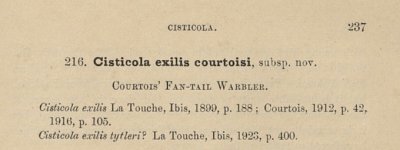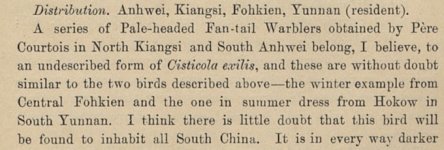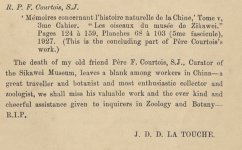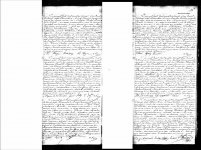-
Welcome to BirdForum, the internet's largest birding community with thousands of members from all over the world. The forums are dedicated to wild birds, birding, binoculars and equipment and all that goes with it.
Please register for an account to take part in the discussions in the forum, post your pictures in the gallery and more.
You are using an out of date browser. It may not display this or other websites correctly.
You should upgrade or use an alternative browser.
You should upgrade or use an alternative browser.
latouchei / Latoucheornis / latouchi / latouchii (1 Viewer)
- Thread starter Taphrospilus
- Start date
More options
Who Replied?Taphrospilus
Well-known member
And what about Elisabeth 1912-1988?
Taphrospilus
Well-known member
You can as well question why he named some elisabethae while one was named mariae.
Think this information came from here.
l_raty
laurent raty
Serilophus lunatus elisabethae, here, "Named after my daughter Elizabeth", 29 Oct 1921.You can as well question why he named some elisabethae while one was named mariae.
Minla ignotincta mariae, here, "Named after my daughter Mary", 29 Nov 1921.
So these namings were not even distant in time, which makes it all the more unlikely that he switched from using one given name to using the other between them.
So she did exist so according to this shipping manifest from 1919 Elizabeth Mary was known as Mary, Jeanne Mary Caroline was known as Jeanne and Elizabeth Charlotte Mary was known as Elizabeth!!
Jeanne Mary Caroline Digues De La Touche
1910–12 May 1922
Elizabeth Charlotte Mary Digues De La Touche
24 November 1912 - 1988.
Jeanne Mary Caroline Digues De La Touche
1910–12 May 1922
Elizabeth Charlotte Mary Digues De La Touche
24 November 1912 - 1988.
Attachments
Last edited:
Taphrospilus
Well-known member
Sorry to come back on this. Do we know as well the birth year of...
Caroline Amanda La Touche née Focken (d. 1945) wife of Irish ornithologist John Digues La Touche (subsp. Brachypteryx leucophris).
I am not really sure how La Touche who was born in France and lived most of his life in China is called an Irish Ornithologist - sure he retired to Ireland in 1921 and remained there till his death in 1935 but...See Laurents post #5 and #6. The family moved to Ireland at the Revocation, returned to France in the 19th century.
Caroline Amanda Bella (Carrie)Dawson-Focken
Birth 1871 Shantou, Guangdong, China
Death 7 Dec 1945 Meath, Ireland
Spouse John (Jean) David Digues La Touche (1861-1935)
The Paris birth is actually their daughter Charlotte Marie Françoise Elisabeth (attached)
Edit I believe the incorporation of the name Dawson is a confusion with her elder sister Pauline Louisa Dawson nee Focken (1867-1938) who married Cecil Percy Dawson (1861-1930).
Her parents were German immigrants to Victoria Australia. Her father was a sea captain who became a pilot in the waters off Hong Kong (Friedrich Wilhelm Focken 1834-1893).
Caroline Amanda Bella (Carrie)
Birth 1871 Shantou, Guangdong, China
Death 7 Dec 1945 Meath, Ireland
Spouse John (Jean) David Digues La Touche (1861-1935)
The Paris birth is actually their daughter Charlotte Marie Françoise Elisabeth (attached)
Edit I believe the incorporation of the name Dawson is a confusion with her elder sister Pauline Louisa Dawson nee Focken (1867-1938) who married Cecil Percy Dawson (1861-1930).
Her parents were German immigrants to Victoria Australia. Her father was a sea captain who became a pilot in the waters off Hong Kong (Friedrich Wilhelm Focken 1834-1893).
Attachments
Last edited:
mb1848
Well-known member
Wikipedia "TheLatin specific epithet of fokienensis (of the species) refers to La Touche's wife, née Caroline Dawson Focken (c. 1871 – c. 1945)"
OD: v.21-23=no.136-153 (1907-1909) - Bulletin of the British Ornithologists' Club. - Biodiversity Heritage Library .
I think the bird is named for the region of China.
A Handbook of the Birds of Eastern China (Chihle, Shantung, Kiangsu, Anhwei, Kiangsi, Chekiang, Fohkien, and Kwangtung Provinces). .
The Key agrees
The Key to Scientific Names - Birds of the World .
OD: v.21-23=no.136-153 (1907-1909) - Bulletin of the British Ornithologists' Club. - Biodiversity Heritage Library .
I think the bird is named for the region of China.
A Handbook of the Birds of Eastern China (Chihle, Shantung, Kiangsu, Anhwei, Kiangsi, Chekiang, Fohkien, and Kwangtung Provinces). .
The Key agrees
The Key to Scientific Names - Birds of the World .
Last edited:
Björn Bergenholtz
(former alias "Calalp")

Mark, note that the Wiki claim you quoted doesn't relate to a Bird.
In full it reads: [my blue and bolds]: " ... a genus of flowering plants from China (belonging to the family Gentianaceae) was named in his honour [i.e. Latouchea (fokienensis) Franch.*], with the Latin specific epithet of fokienensis (of the species) refers to La Touche's wife, née Caroline Dawson Focken (c. 1871 – c. 1945)."
However, I have no idea what-so-ever on why Wikipedia claim such was/is the case (re. the specific epithet, that is), neither do I understand how anyone could come up with such an explanation. Trying to stretch the name of any Miss Focken into fokienensis [with the toponym ending -ensis (of/from), clearly linking it into Geography, location, occurence, presence, Habitat] is, in my mind, ... well, a bit too far-fetched.
See the OD for:
• L. ["Latouchea genus nov."] fokienensis FRANCHET 1899 (here), no dedication, no explanation, only:
Enough said (I think) ...
Either way, re. the Bird (in the first link/OD above, in post #50), I totally agree:, "The Fohkien Sand-Martin", "C. [Cotile] fohkienensis, La Touche" 1908, has (equally) absolutely nothing to do with any (Focken) lady surrounding Mr La Touche.
Richmond card here.
---
Paul, in my MS I (still) have "John David La Touche" as "French-Irish" (born in France, of Irish Heritage), even if only mentioned in context (as in post #4).
For what it's worth.
Björn
*If the Author of that Wiki-piece was 'thinking' of the Plant "Rhododendron Latoucheæ sp. nov." (described in the same Paper) it would have been (or at least it could have been) a different case all together ... (but, as it's about a Plant, I'll leave it there/here, as of less concern, for us on BirdForum).
In full it reads: [my blue and bolds]: " ... a genus of flowering plants from China (belonging to the family Gentianaceae) was named in his honour [i.e. Latouchea (fokienensis) Franch.*], with the Latin specific epithet of fokienensis (of the species) refers to La Touche's wife, née Caroline Dawson Focken (c. 1871 – c. 1945)."
However, I have no idea what-so-ever on why Wikipedia claim such was/is the case (re. the specific epithet, that is), neither do I understand how anyone could come up with such an explanation. Trying to stretch the name of any Miss Focken into fokienensis [with the toponym ending -ensis (of/from), clearly linking it into Geography, location, occurence, presence, Habitat] is, in my mind, ... well, a bit too far-fetched.
See the OD for:
• L. ["Latouchea genus nov."] fokienensis FRANCHET 1899 (here), no dedication, no explanation, only:
And, note that this Plant was described in Messieurs Finet's and Franchet's Paper: "Sur une Collection de Plantes réunie dans le Fokien" a k a "Plantes du Fokien (China)".Hab. — Les montagnes de Kuantun. — Mai 1898.
Enough said (I think) ...
Either way, re. the Bird (in the first link/OD above, in post #50), I totally agree:, "The Fohkien Sand-Martin", "C. [Cotile] fohkienensis, La Touche" 1908, has (equally) absolutely nothing to do with any (Focken) lady surrounding Mr La Touche.
Richmond card here.
---
I am not really sure how La Touche who was born in France and lived most of his life in China is called an Irish Ornithologist ...
Paul, in my MS I (still) have "John David La Touche" as "French-Irish" (born in France, of Irish Heritage), even if only mentioned in context (as in post #4).
For what it's worth.
Björn
*If the Author of that Wiki-piece was 'thinking' of the Plant "Rhododendron Latoucheæ sp. nov." (described in the same Paper) it would have been (or at least it could have been) a different case all together ... (but, as it's about a Plant, I'll leave it there/here, as of less concern, for us on BirdForum).
Last edited:
mb1848
Well-known member
So sorry Björn and all. I do suffer from a variant of Cotard delusion where I confuse plants with animals. But that really is no excuse. I did find a Plum Rust Mite which was named for Miss Focken: Aculus fockeni .
Sorry again it was not named for Miss F.
Sorry again it was not named for Miss F.
Phyllocoptes fockeui Nalepa & Trouessart, 1891
Last edited:
Taphrospilus
Well-known member
- Cisticola exilis courtoisi La Touche, JDD 1926 OD A handbook of the birds of eastern China (Chihli, Shantung, Kiangsu, Anhwei, Kiangsi Vol 2, p. 237 (not seen)
- Geokichla citrina courtoisi (Hartert, EJO 1919) OD here
Named in honour of Father Courtois, Curator of the Sikawei Museum, at the request of Mr. La Touche.
- Pterorhinus courtoisi (Ménégaux, HA 1923) OD here
Ces deux spécimens ont été donnés au Muséum par le Père Courtois, directeur du Musée de Zi-Ka-Wei, près Changaï, auquel nous avons dédié l'espèce.
The Eponym Dictionary of Birds
Courtois's Laughingthrush Garrulax courtoisi Menegaux, 1923 [Alt. Blue-crowned Laughingthrush; formerly Garrulax galbanus courtoisi]
Orange-headed Thrush ssp. Zoothera citrina courtoisi Hartert, 1919
The Reverend Fréderic Courtois (1901–1928). He was an amateur naturalist who became Director of the Natural History Museum in Sikawei, near Shanghai He wrote Les Oiseaux du Musée de Zi-Ka-Wei (1912). An amphibian is named after him.
The Key to Scientific Names
Revd. Père Frédéric Courtois (1860-1928) French missionary to China 1901-1928, Curator of Sikawei Mus., naturalist (subsp. Cisticola exilis, subsp. Geokichla citrina, Pterorhinus).
Birth Record here p. 314/350 Cote 3 E 091/004 as Louis Frédéric Courtois.
No bird:
Quasipaa courtoisi Angel, 1922 OD here
I am not sure yet when and where he exactly died.
Taphrospilus
Well-known member
l_raty
laurent raty
- Cisticola exilis courtoisi La Touche, JDD 1926 OD A handbook of the birds of eastern China (Chihli, Shantung, Kiangsu, Anhwei, Kiangsi Vol 2, p. 237 (not seen)
Can be seen here. Choose "Sign in as a Guest User" to login. The description is indeed on p. 237, which is image 279/558. (This is, however, Volume I, not Volume II. (Volume II can be seen here.))
216. Cisticola exilis courtoisi, subsp. nov.[...]
COURTOIS' FAN-TAIL WARBLER.
A series of Pale-headed Fan-tail Warblers obtained by Père Courtois in North Kiangsi and South Anhwei belong, I believe, to an undescribed form of Cisticola exilis, and these are without doubt similar to the two birds described above—the winter example from Central Fohkien and the one in summer dress from Hokow in South Yunnan.
Last edited:
Björn Bergenholtz
(former alias "Calalp")

Or see the excerpts below [from the same Book/Volume, in the NUS (National University of Singapore) Library, as of/in Laurent's link in post #56]:


And, note the remark on p.482:

The same volume also includes:
• Garrulax/Dryonastes courtoisi (Menegaux), a k a COURTOIS’S LAUGHING-TRUSH, on pp.58–59
• Turdus/Geocichla citrina courtoisi (Hartert), a k a THE CHINESE ORANGE-HEADED GROUND-TRUSH, on p.114–115.
Also note the following text, from the Preface (on p.v.):

R. [Révérend/Reverend] P. [Père/Pater/Father] F. [Frédéric] Courtois, S.J. (Latin: Societas Jesu (Jesuit)]
Enjoy!
Björn
PS. The (original) publication of this Work, in various, multiple Parts/Booklets (1925–1934) is a complex case. See for example here (or here, alt. here). However, the full Title reads: A Handbook of the Birds of Eastern China (Chihli, Shantung, Kiangsu, Anhwei, Kiangsi, Chekiang, Fohkien, and Kwangtung Provinces. ...


And, note the remark on p.482:

The same volume also includes:
• Garrulax/Dryonastes courtoisi (Menegaux), a k a COURTOIS’S LAUGHING-TRUSH, on pp.58–59
• Turdus/Geocichla citrina courtoisi (Hartert), a k a THE CHINESE ORANGE-HEADED GROUND-TRUSH, on p.114–115.
Also note the following text, from the Preface (on p.v.):

R. [Révérend/Reverend] P. [Père/Pater/Father] F. [Frédéric] Courtois, S.J. (Latin: Societas Jesu (Jesuit)]
Enjoy!
Björn
PS. The (original) publication of this Work, in various, multiple Parts/Booklets (1925–1934) is a complex case. See for example here (or here, alt. here). However, the full Title reads: A Handbook of the Birds of Eastern China (Chihli, Shantung, Kiangsu, Anhwei, Kiangsi, Chekiang, Fohkien, and Kwangtung Provinces. ...
Last edited:
l_raty
laurent raty
The original wrappers were not preserved in the Univ. of Singapore copy, hence the dates of publication of the parts cannot be retrieved from this copy. The limits between parts can easily be deduced, however, as the plates corresponding to each part are bound at the end of the concerned part.
Below is a rapid compilation of the parts' contents and dates of publication, based on 'Recent Literature' reports in Auk, and the contents of the books. (This info may well exist elsewhere, but I did not run into it in a quick search. Zoonomen doesn't provide it.)
La Touche JDD. 1925-1934. A Handbook of the Birds of Eastern China (Chihli, Shantung, Kiangsu, Anhwei, Kiangsi, Chekiang, Fohkien, and Kwangtung Provinces). Volume I, Volume II. Taylor and Francis, London.
Vol. I
part 1 : Jul 1925 : pp. 1-96, pll. I-III. (In Auk: here.)
part 2 : Dec 1925 : pp. 97-192, pll. IV-VII. (In Auk: here.)
part 3 : May 1926 : pp. 193-292, pll. VIII-IX and map. (In Auk: here.)
part 4 : Aug 1927 : pp. 293-398, pll. X-XIII. (In Auk: here.)
part 5 : Jul 1930 : pp. 399-500, i-xx, title page, etc. (In Auk: here.)
Vol. II
part 1 : May 1931 : pp. 1-96, pll. XIV-XV. (In Auk: here.)
part 2 : Jan 1932 : pp. 97-192, pll. XVI-XVII. (In Auk: here.)
part 3 : Dec 1932 : pp. 193-288, pll. XVIII-XIX. (In Auk: here.)
part 4 : Apr 1933 : pp. 289-400, pll. XX-XXII. (In Auk: here.)
part 5 : Jan 1934 : pp. 401-496, pll. XXIII-XXIV. (In Auk: here.)
part 6 : May 1934 : pp. 497-566, i-xxiii, title page, etc. (In Auk: here.)
Taphrospilus
Well-known member
And; note that "C. jankowskii" (here called "Alpheraky's Swan" alt. Jankowski's Swan) today, by most, is considered a synonym of Cygnus (colombianus) bewicki ... !?
Emberiza jankowskii Taczanowski, 1888 OD ser.5:v.6=no.21-24;Index v.1-6 (1883-1888) - Ibis - Biodiversity Heritage Library
Pica pica jankowskii Stegmann, 1928 OD Stegmann B. 1928. Die ostpaläarktischen Elstern und ihre Verbreitung // Ежегодн. Зоол. му-. зея Акад. наук СССР 28, 3: 366-390 (not seen)
The Eponym Dictionary of Birds
A comprehensive dictionary listing all the people whose names are commemorated in the English and scientific names of birds.Birdwatchers often come across bird names that include a person's name, either in the vernacular (English) name or latinised in the scientific nomenclature. Such names are...
books.google.de
Jankowski's Bunting Emberiza jankowskii Taczanowski, 1888 [Alt. Rufous-backed Bunting] Jankowski's Swan Cygnus columbianus jankowskyi Alphéraky, 1904 NCR [Alt. Tundra Swan; NUI Cygnus columbianus bewickii]
Mikhail Ivanovich Jankowski (1842–1912) was a Polish nobleman trained as a collector by Dybowski (q.v.). With Dybowski, Godlewski (q.v.) and others he was exiled in Siberia, following the Polish Uprising (1863). Although he was pardoned (1873) he stayed in Manchuria. He continued to collect birds for the Warsaw Zoological Collection and later for the Branicki Museum. After release exiles were obliged to settle in remote areas. With his fellow exiles he undertook a scientific expedition along the Amur River (1872–1874); here they studied the fauna of Lake Baikal and other regions of eastern Siberia with the help of the Zoological Cabinet back in Poland. He settled in Sidemi Bay (1875), which now bears his name, and there created an experimental model farm. He bred a prize-winning strain of horses and domesticated deer, building the first herd in Russia, and cultivated ginseng. He managed the goldfields on Askold Island (1876) and later a printshop. He was a renowned hunter (called 'four -eyes' by the locals) yet advocated conservation of the Taiga and its fauna. His interests were very wide-ranging including astronomy, archaeology (a local prehistoric culture still bears the name 'Jankowski Culture'), agriculture, geography and all natural history. He discovered three birds as well as over 100 species of butterfly, 17 of which carry his name. His son Y. M. Jankowski (q.v.) also had a bird named for him.
Eurasian Magpie ssp. Pica pica jankowskii Stegmann, 1928 NCR [JS Pica pica anderssoni]
Yura (George) Michailowitch Jankowski (sometimes 'Yankovsky') (1879–1956) was a hunter who lived in the region of Vladivostock, and then (1923) North Korea.
The Key to Scientific Names - Birds of the World
Species accounts for all the birds of the world.
Michał Jankowski (1842-1912) Polish naturalist exiled to Siberia 1863-1903 (syn. Cygnus columbianus bewickii, Emberiza, syn. Pica pica sericea).
So small note. Here as well How a Polish ENEMY of Russia ended up an outstanding Russian scientist and industrialist it tells us:
Jankowski, who had Russified his name to Mikhail Ivanovich (Yanovich) Yankovsky, settled in Ussuriland in the Russian Far East
If the Pica pica jankowskii was for his son is unknown to me as I haven't seen the OD and if I would not be able to read the russian text. But if the answer is yes the BOW key need some correction.
Last edited:
l_raty
laurent raty
If the Pica pica jankowskii was for his son is unknown to me as I haven't seen the OD and if I would not be able to read the russian text. But if the answer is yes the BOW key need some correction.
I can't find the OD either, but references to the original work appearing in other publications suggest :
Stegmann B. 1928. Die ostpaläarktischen Elstern und ihre Verbreitung. Ежег. Зоол. муз. Акад. наук СССР / Annu. Mus. Zool. Acad. Sci. URSS, 28: 366-390.
...which is given with a German title even in the Russian literature (e.g.: https://www.researchgate.net/publication/367190141) : I would expect that it was published in German. (The journal can currently be accessed in Google Books [from the US] up to vol. 27 : maybe next year...?)
The Richmond Index lists 4 new sspp described by Stegmann in this work, Pica p. alashanica, P. p. amurensis, P. p. hemileucoptera and P. p. jankowskii, none of which appears to have been based on new material. (I.e., this was a typical revision work, based on the preexisting collections of the St-Petersburg [Leningrad] Museum.) According to its Richmond card, Pica p. jankowskii was based on a type collected near Vladivostok by "M. Jankowski" in June 1884.
I would be hesitant to accept the suggestion of the Eponym dictionary without having seen the OD.
Last edited:
Similar threads
Users who are viewing this thread
Total: 2 (members: 0, guests: 2)






